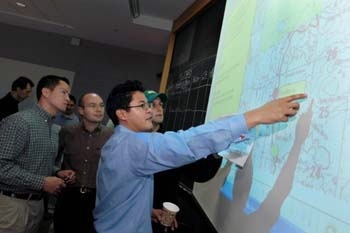You don't have to ask twice if Sloan School students want to step in and take charge.
Seventy of them showed up to participate in the "Bosnian Peace-Keeping Force," a two-day, real-time simulation of an international rescue mission designed to develop leadership skills using a fictionalized model of the atrocity that displaced Bosnian refugees in the 1990s.
The simulation is one of more than a dozen leadership workshops offered during the Sloan Innovation Period (SIP) in October, an intense week of leadership training offered at the midpoint of each semester. Regular classes are suspended, and Sloan M.B.A. students enroll in seminars and activities taught by faculty and visiting instructors.
"The course is designed to teach students how to engage in leadership activities during crisis situations," said Deborah Ancona, the Seley Distinguished Professor of Management who chairs the MIT Leadership Center, which was started last spring to develop the next generation of leaders through education, rigorous research, global dialogue and action. "The time pressures, rapidly developing events, dangerous terrains and moving targets are all designed to teach students leadership skills."
In the simulation, the refugees will perish if relief organizations do not quickly locate them and provide assistance. Students break into governmental and non-governmental groups--military, intelligence, relief, rescue, humane and other organizations--which at times work at cross-purposes to achieve organizational goals. Two indigenous groups, the "Lowlanders" and the "Highlanders"--alleged victims and perpetrators in the incident--are part of the scenario.
First-year student Thomas Greene was part of a reconnaissance unit and experienced the frustration of sitting at a roadblock for an hour and a half, along with the joy of finding a refugee and securing a translator. "Up until now, it's been classroom, classroom, classroom," Greene said. "This is a good break from the routine and a great way to learn. The group dynamics are interesting; you get to see how people respond to different situations."
Adam Albrich, a helicopter pilot who flew missions in Bosnia and Afghanistan as an officer with the U.S. Army before coming to Sloan, worked in the control room during the simulation. "The radios, roadblocks, planning, translations and constant changes--everything was very similar to a real emergency rescue operation except that what the Sloan students accomplished in 12 hours would have taken the military a month," Albrich said.
The SIP leadership sessions are part of a set of workshops, courses and other activities developed and offered as part of the MIT Leadership Center, according to Mary Schaefer, executive director of the center. "The center's initiatives closely align leadership and team development with science, engineering and management skills--leveraging the best of MIT--while addressing and solving practical problems affecting society and the economy."
"Courses like this one," said Sloan Dean Richard Schmalensee, "are part of the school's commitment to developing principled, innovative leaders who will improve the world. We are developing and evaluating innovative education approaches while expanding dialogue with global experts and leaders."
Many criteria are used to evaluate the participants' performance during the simulation, including actual mission results. "The group managed to get all of the refugees to safety, but secured only two-thirds of the supplies needed," said Bruce Newsome, a former Wharton professor and originator of the simulation who is now with RAND in Santa Monica, Calif. While the MIT Sloan students were anxious to learn the results, they were equally curious to know how their performance compared with their peers at Wharton. "You did better," said Newsome.
A version of this article appeared in MIT Tech Talk on December 8, 2004 (download PDF).






